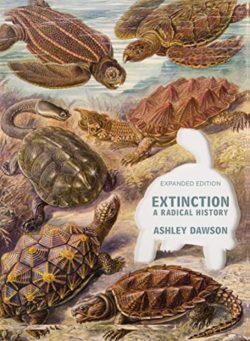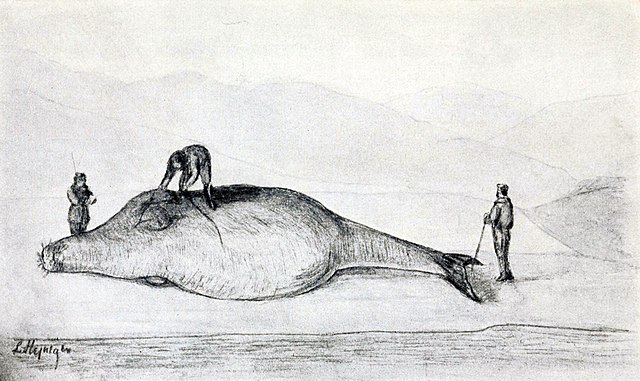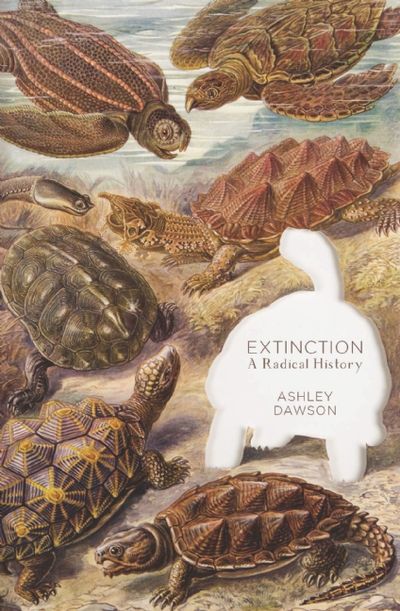For the past hundred or so years, species have been dying out at a rate not far off from the Cretaceous/Paleogene extinction, which resulted from an asteroid smashing into the earth, or the Permian/Triassic extinction, triggered by some of the largest volcanic eruptions this planet has ever known. The cause of the current mass extinction is of course not a meteor or a volcano, but us. That the cause of this mass extinction is us raises a question of blame. You don’t make ethical judgements about meteors or volcanoes. But about humans, you do.

I mean, not everybody does. There are pop science writers, and serious people too, who say that extinction of other species is the “natural” result of human technological advancement and population spread, both of which result in turn from “natural” impulses lying at some level of our programming where thinking and reflection and rational decision-making can’t reach. So, not guilty! Like the meteor and the volcano, we’re just doing what it’s in our nature to do. You only blame someone for what they do by choice.
Then there are people like Ashley Dawson, the author of Extinction: a Radical History (OR Books) who feel that our role in the current spate of extinctions stems not from immutable human nature but from a particular configuration of human forces that we ought to try to change before it’s too late. Dawson calls this configuration of forces “capitalism,” which in this case names a system of production that pushes people with lots of money to make and sell as many widgets as they can, as cheaply as possible. Roughing it out, the argument is that a system like that encourages people to take advantage of nature as a resource and as a dumping ground, since that’s a cost savings both ways, and that treating nature that way is bound to cause more extinctions.
To blame or not to blame? Each approach has its advantages. For example, people who think that “it’s just human nature” to cause extinctions get to use a scientific-sounding vocabulary that treats humans as just another population of animals—albeit one that has a particularly malignant effect on the ecologies it invades.
A feature of scientific language is that it can generate testable hypotheses. The “human nature” crowd, from Paul Martin to Jared Diamond, has based its case on the apparent coincidence of human colonization with prehistoric megafauna extinction everywhere outside of Africa, which is exactly what you’d expect if humans “naturally” drove species to extinction. But new research keeps changing the timelines for human colonization, while the extinction chronology stays stubbornly fixed. To make the spread of humans into North America cause the extinction of the Mammoth, for instance, you need that spread to have happened about 12000 years before present. As Paulette Steeves has recently illustrated in The Indigenous Paleolithic of the Western Hemisphere (University of Nebraska Press), archaeological sites like La Venta in Chile are producing a new consensus date of 15000 years, perhaps as many as 24000 years, BP for the habitation of the Americas. So there, as elsewhere in the old world, the figure of Homo extinctor is starting to look like a figment of last century’s imagination.
The “human nature” theory is left with just one remaining advantage, then, which is that it helps folks who might seem to have benefited disproportionately from the ongoing mass extinction avoid taking a disproportionate share of the blame. No wonder that academics from the USA, former home of the passenger pigeon and the Carolina parakeet and the rocky mountain locust, have been particularly prominent in pushing an account of those extinctions that turns them into expressions of a kind of biological manifest destiny.
That it makes us feel good is, as Dawson points out, not a very good reason for clinging to a theory. His account of capitalist development as driver of extinction offers a compelling alternative, one with the explanatory power to account for why rates of human-caused extinction differ so dramatically across time and space. It’s a feel-bad story, especially for those of us whose lifestyle depends on advanced capitalism, but just for that reason it has a special claim to our attention.
Dawson argues a twofold connection between capitalism and mass extinction. First, capitalists treat wild animals and plants as a resource and appropriate them directly, without any respect for the sustainability of populations. It’s at this point difficult to disentangle capitalism from settler colonialism: consider the Dodo, eaten to death by French and Dutch sailors serving both mercantile and colonial interests, or the Steller’s Sea Cow, annihilated to fill the bellies of European merchants and explorers in the North Pacific. We can think of those extinctions as part of “primitive accumulation,” the Marxist term for the violent appropriation of land and resources that gave European entrepreneurs the capital they needed to get the industrial revolution going.

Whaling, on the other hand, offers a more clear-cut case of capitalist exploitation of animals as a natural resource. Immense factory-ships roamed the world in search of whales to kill and process. The results of that processing were mass-market products for consumers (e.g. lamp oil) as well as specialized components for advanced industrial production (e.g. machine grease). Whales were the oil wells of the nineteenth century; later on, oil wells became the whales of the modern age.
Yet it is a striking fact that no cetacean species were driven to extinction by industrial whaling. Many were driven to the edge of extinction but none were completely exterminated. That turns out to be the way that a lot of the stories Dawson tells about the industrial exploitation of wildlife end up. About the hunting of beavers or ermines for pelts, for instance. Neither beavers nor ermines went extinct, even though most of them died.
That might make you wonder, why talk about all this mass death just in terms of extinctions? Why not talk instead about all the big chunks of nature that have passed out of the world to help capital reproduce itself? The waters off the coast of Northern California, for instance, rich in fish until the sardine fleets cleaned them out in the early twentieth century. Nothing went extinct, but a world did die.
The difference extinction makes, I guess, is that then you don’t have much hope of bringing back what was lost. You can bring back the red abalone or the grey wolf so long as there’s a breeding population somewhere. But good luck bringing back, say, the Golden Lion Tamarin, which is dead down to the last individual. So extinction seems like a special kind of insult, a mistake you can’t undo. “Nearly extinct” doesn’t have the same impact, even if what disappears in that “near extinction” is a whole ecology that might, in its own way, also count as a permanent loss.
The material gathered by Dawson gives the jarring impression that capitalism kills species fastest precisely when it’s not interested in them as a resource (“collateral ecocide” in Dawson’s vocabulary). Indifference is what drives mass extinction. In the Amazon, for instance, species don’t disappear because people want to eat them but because they happen to depend on a habitat that people want to clear for grazing cattle, which people do want to eat. So plants and animals are going extinct “by accident,” because they stand in the way of exploiting other externalities.
The problem of negative externalities eventually brings Dawson to discuss the biggest “oops” of all, anthropogenic climate change, which results from a hundred and fifty years of people treating the atmosphere as an inexhaustible dumping ground. Dawson blames capitalism, and it’s hard to disagree—not only because carbon emissions scale with industrialization, but also because the capitalist drive to get people to buy and “enjoy” things they didn’t know they needed has made it hard for Western consumers to accept the kinds of sacrifices that are going to be needed to limit the impact of global warming. Which is already causing the incidental extinction of species all over the world. In the centuries to come, many more species are going to mount the chopping block, including, if we push things far enough, human beings.
That bleak forecast brings us to an important question raised in the final chapters of Extinction: how can we imagine the history Dawson has told ending in anything else than a planetary shipwreck in which most of the world’s inhabitants perish? As he acknowledges, any honest look at the state of the environment is going to tempt us to despair. Are there any believable futures that can help us resist that temptation? In short, what can we hope for?
Dawson starts addressing that question by canvassing some of the answers that have emerged within capitalist technoscience. One particularly dystopian option is the proposal by geneticists like George Church that extinct species should be restored to life by synthetic means, either through the insertion of DNA into the fertilized egg of an extant near-relative which can then be brought to term in vivo or else by entirely in vitro procedures yet to be devised. That would be a neat trick. As Dawson points out, the upshot of that kind of thinking is to give capitalists carte blanche to cause extinctions on the pretext that scientists will be able to reverse them later on. And any species resurrected in this way would have to remain a kind of zoo curiosity, since whatever capitalist projects had driven it to extinction would presumably still be ongoing. Species could survive, but parts of nature would still end up being destroyed. Maybe the death of an ecosystem really is what matters after all.
Can we hope for anything more than capitalism “fixing” some problems in order to make others much worse? Not without hoping for systemic change, says Dawson. We can’t hope for an end to the ongoing wave of extinctions if we’re not willing to do something about its deep causes, among which would have to be included the carbon- and manufacturing-dependent lifestyles of most readers of Dawson’s book. Cutting loose from those dependencies—“degrowth”—would mark one major step toward ending the Sixth Extinction. But Dawson, sensitive to the ways in which such an emphasis on individual consumer choice may tend to preserve the status quo, insists that the political is not just the personal. We also need collective action, both to punish capitalists for treating nature as an externality and to put citizens of the global south in a position where they can afford not to sell their piece of the planet off for scrap.
Redistribution is key because, as Dawson has shown, resource flows from the margins of the capitalist world system to its American and European centers have been the major occasion for the exploitation of nature and the destruction of animal species over the past two hundred years. The landscape of that system may be changing, as Martin Arboleda argues in his recently published Planetary Mine, but the system’s twin tendencies to exhaust our planet’s resources and produce more inequality remain constant. It’s thus hard to argue with Dawson’s conclusion that “all conservation is radical conservation” (p. 94). He makes a compelling case that capitalism has caused the recent wave of extinctions and that, if we fail to address that root cause, the only thing we can hope for is more of the same.
